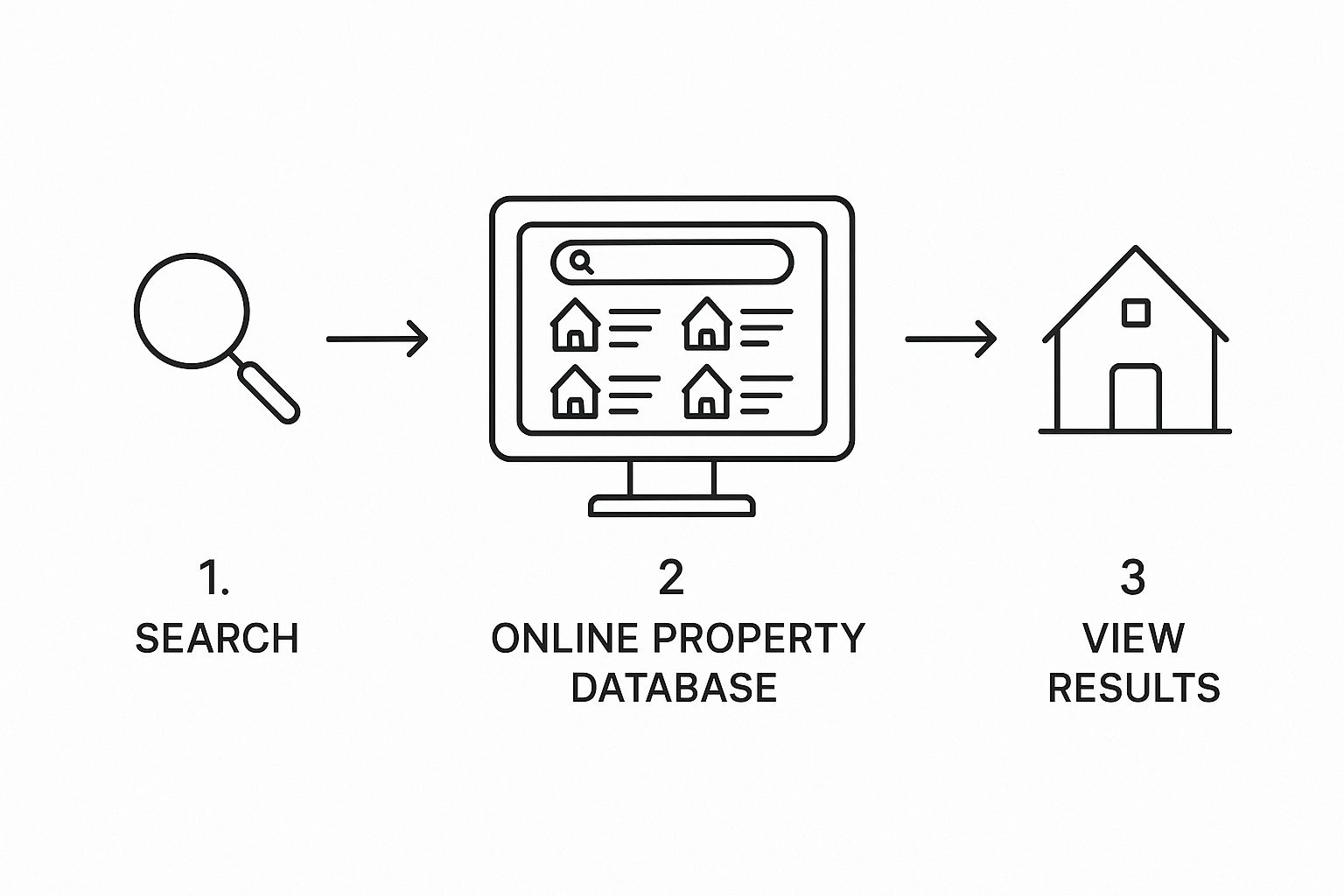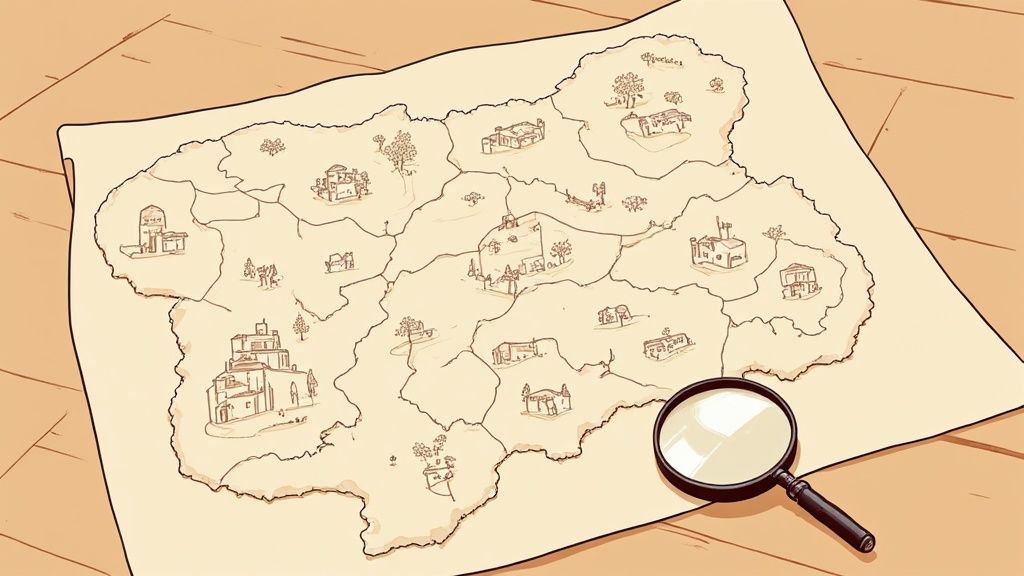How to Research Property History Like a Pro
Learn how to research property history with our guide. Discover expert tips for uncovering deeds, permits, and the hidden stories behind any property.
Posted by

When you’re looking into a property’s background, you’re essentially piecing together its life story. This means digging into the official stuff—deeds, tax records, and legal documents—and then comparing that with physical clues you can find on old maps and in local archives. It’s this combination of legal and physical history that gives you the full picture, protecting your investment from some seriously nasty surprises down the road.
Why a Property’s Past Matters for Your Future
Before we get into the how, let's talk about the why. Understanding a property's history is so much more than just satisfying curiosity. It’s a financial and legal roadmap that directly impacts your future as an owner. Trust me, skipping this part is a gamble you don't want to take.

Imagine this: you've just closed on what seems like a perfect piece of land, only to find out there are thousands of dollars in unpaid liens attached to the title. Guess who inherits that debt? You do. Or maybe that charming extension on the back of the house was built without the proper permits, and now the city is telling you it has to be torn down—on your dime. These aren't just scare tactics; they’re real, costly headaches that happen all the time to buyers who didn’t look closely at the paper trail.
Protecting Your Biggest Investment
I always tell people to think of property research less like a chore and more like essential protection for what is probably one of the biggest investments you'll ever make. When you do it right, you’re setting yourself up for success.
Proper research helps you:
- Avoid legal messes: You can uncover hidden easements, liens, or boundary disputes that might restrict how you can use the land.
- Confirm the property's value: You'll get a clear picture of the assessment history and spot red flags that could impact its true market price.
- Check the structural history: Reviewing permit records confirms that any renovations or additions were done correctly and up to code.
Doing this groundwork lets you move forward with confidence. It turns a hopeful guess into a smart, calculated investment backed by solid facts.
A property's paper trail is its autobiography. Reading it helps you understand where it's been, what it's worth, and what problems might be hiding between the lines. It’s your first line of defense against future financial headaches.
Navigating the Modern Real Estate Market
Getting good at researching a property’s history is a fundamental skill, especially now. We're talking about a global real estate market that's ballooned to $7.38 trillion. As the market keeps expanding, digital tools have completely changed the game, making it easier than ever for buyers to access layered ownership data and historical records.
You can find more data about this trend in the global real estate market report. It’s this blend of new technology and old-school historical data that makes thorough research such a critical step in any modern property deal, whether in Japan or anywhere else in the world.
2. Unearthing a Property's Past: Your Starting Point in Japan
Before you can truly understand a property, you need to dig into its history. Think of yourself as a detective. Every property in Japan has a story, recorded in official documents that trace its ownership, boundaries, and physical changes over time. Your first move is to gather the basic clues that will unlock these records.
Without the right starting information, you're essentially flying blind. You'll waste hours searching for a needle in a haystack. The most crucial piece of the puzzle is the property's official address, known as the 地番 (chiban). This isn't always the same as the mailing address, so getting the correct one is key.
The Official Record Keepers
In Japan, your investigation will lead you to the 法務局 (Hōmukyoku), the Legal Affairs Bureau. This is the official keeper of all property records. It’s where you'll find the登記簿謄本 (tōkibotōhon), the official property registration certificate, which is the cornerstone of any property research.
Don't overlook local municipal offices, either. The city or ward office holds valuable information on zoning, building regulations, and historical land use maps that can fill in critical gaps in the property's story.
The Key Documents That Tell the Story
As you get started, you'll come across several important documents. Each one gives you a different piece of the puzzle. The 登記簿謄本 (tōkibotōhon), or property register, is your primary source for the legal history—who owned it and when.
Then there are maps like the 公図 (kōzu), which shows the official boundaries and shapes of land parcels. For the physical history, building permits and inspection certificates from the local municipal office reveal what was built, when, and if it met the legal standards of the time.
Here's a quick guide to the essential documents you’ll be working with when researching property history. Understanding what each one contains and where to get it will make your job much, much easier.
Essential Documents for Property History Research
| Document Type | Information Provided | Primary Source |
|---|---|---|
| 登記簿謄本 (tōkibotōhon) | Complete chain of ownership, mortgages, liens, and legal rights. | Legal Affairs Bureau (法務局) |
| 公図 (kōzu) | Official parcel boundaries, shape, and location relative to neighbors. | Legal Affairs Bureau (法務局) |
| 地積測量図 (chiseki sokuryōzu) | Detailed survey map with precise land measurements. | Legal Affairs Bureau (法務局) |
| 建築確認済証 (kenchiku kakunin zumishō) | Building permit confirming plans met legal standards at the time. | Local Municipal Office |
These documents are the bedrock of your research. Once you have them, you can start to connect the dots and build a clear, comprehensive timeline of the property's entire life. This initial legwork is what separates a surface-level glance from a deep, insightful analysis.
Getting the Official Story from Public Records
Alright, you've done your preliminary legwork. Now it's time to roll up your sleeves and dig into the official records. This is where you move from anecdotal evidence to hard facts, uncovering the documented life story of the property. Your main destinations for this are the local government offices, both their digital portals and their physical archives.
The first concept you need to get familiar with is the chain of title. Think of it as the property's biography, a sequential record of every time it changed hands. It runs from the current owner all the way back to the original one. Any gap or weird inconsistency in this chain is a major red flag that needs a much closer look.
Not too long ago, this meant spending days in the dusty backroom of a local courthouse, poring over massive, leather-bound books. Thankfully, things have changed. As of 2024, over 60 countries have digitized and maintain detailed residential property data, which cuts research time from weeks down to a few hours.
Your Go-To Sources: The County Offices
Your investigation will focus on three key government departments. Each holds a different piece of the property's puzzle, and you'll want to tap into all of them to get the full picture.
- The County Recorder's Office: This is your ground zero. The Recorder’s Office is the official keeper of every document related to property ownership. Deeds, mortgages, liens, easements—it's all here.
- The Tax Assessor's Office: This office figures out the property's value for tax purposes. Their records are a treasure trove of information, showing a history of valuations, tax payments, and even physical details like square footage and the number of rooms.
- The Building or Planning Department: For anything related to the physical structure itself, this is the place. You can pull building permits, find inspection records, and check zoning information, which tells you what can legally be built on the land.
The image below gives you a feel for how a modern online property database works. It’s often the first stop in today's research process.

As you can see, structured data makes it much easier to filter and pinpoint the exact documents you need, turning a potentially overwhelming search into a manageable task.
How to Read Between the Lines of Old Documents
Once you have the documents in hand, you need to know what to look for. A deed from a century ago can be full of dense legalese, but a few key details tell most of the story.
First, track the names of the grantor (the seller) and the grantee (the buyer) to piece together that chain of title. Double-check the property description to make sure it matches what you know today. Keep a sharp eye out for any mention of easements (the right for someone else to use part of the property) or covenants (restrictions on how you can use it). Finding an unexpected utility easement could scuttle your plans for that new garage.
A pro tip: Don't just skim the documents. Actively look for what isn't there. A mysterious gap in the ownership history or a series of rapid-fire sales can be telltale signs of title problems or financial trouble tied to the property.
Spotting Red Flags in the Permit History
The building department’s files are a goldmine for understanding a structure's physical health. A clean permit history with all the inspections signed off is a fantastic sign.
On the flip side, a lack of permits for major renovations—like a completely redone kitchen or a finished basement—is a huge red flag. It suggests unapproved work was done. This kind of corner-cutting can hide serious safety issues and might stick you with a bill for expensive repairs to bring everything up to code. This is a crucial step in your research, as it directly impacts your future costs and safety. Verifying the legal standing is foundational, and you can learn more about how to verify property ownership in our detailed guide.
Using Digital Tools to Speed Up Your Search
While digging through official records is the only way to get the final word on a property’s history, let's be realistic—it's slow. Thankfully, modern digital tools can give you a massive head start. These resources pull together public data into a single place, turning what could be hours of manual searching into just a few minutes of clicking. Think of them as your first pass, the tool you use to get the lay of the land before you go deep.
Government-run GIS (Geographic Information System) mapping systems are a great place to begin. These interactive maps let you see the property lines, check out the topography, and sometimes even look at historical changes in land use. If you’re trying to understand the physical context of a property, these visual tools are indispensable.
Streamlining Research with Third-Party Databases
Beyond the government sites, third-party databases like mapdomo are incredibly helpful. They consolidate data from multiple sources, so instead of jumping between three different government websites for deeds, tax info, and old photos, you can often find it all in one spot. This approach saves a ton of time.
A quick search on a platform like this can instantly pull up:
- Ownership History: A clear timeline of previous owners helps you quickly trace the chain of title.
- Sales Records: See what the property sold for in the past, giving you valuable context for its current value.
- Historical Maps and Photos: Old aerial shots or survey maps are fantastic for seeing how the property and the neighborhood around it have changed over the decades.
These platforms are built to give you a comprehensive snapshot, pointing you directly to the areas that need a closer look. They don't replace the official documents, but they tell you exactly which documents you need to pull first.
The real power of digital property research tools isn't that they have all the answers. It's that they help you ask the right questions. Use them to spot inconsistencies and identify red flags, then turn to official records for verification.
Proven Strategies for Digital Property Research
To get the most out of these tools, you need a smart approach. I always start broad with just the address, then begin narrowing things down with filters. You can search by an owner's name, the parcel number, or even a specific date range if you're hunting for a particular transaction.
But here’s a crucial piece of advice: the data you find online is only as good as its source. A common mistake is to take what you see on a third-party site as absolute fact. Always, always cross-reference what you find with primary sources from the official registry office or tax assessor.
For instance, if an online database says a lien was released in 2015, your next step is to find the official release document in the public records to confirm it. This two-step process—discovery and verification—is the core of any solid property history investigation. These digital shortcuts simply make you a much more effective and efficient researcher.
Uncovering the Physical History of the Property
Official documents tell one side of the story, but the richest details often lie far outside government offices. A property's true history is etched into its structure, captured in old photographs, and held in the memories of those who have called the neighborhood home for decades. This is where you get to play detective, piecing together its physical and social past.

This part of your research can unearth crucial context that paperwork will never show you. Think about past floods that never made it into a formal report, simmering neighborhood disputes, or significant alterations done quietly without permits. These are the kinds of details that can directly impact your quality of life and your wallet down the road.
Digging into Historical Archives
Your local library or historical society can be an absolute goldmine. These places often hold collections that can bring a property’s past to life in a way legal documents simply can't.
When you go, here’s what you should be looking for:
- Sanborn Fire Insurance Maps: These maps are incredibly detailed, created for insurance assessments. They show the footprint, building materials, and use of nearly every structure in a city, letting you see your home’s original size and shape.
- Historical Photographs: Archives frequently have street-level photos. Finding a picture of your house from 50 or even 100 years ago can reveal fascinating changes, like a porch that was removed or windows that were restyled.
- City Directories: Think of these as old-school phone books. They list residents by address, so you can trace who lived in the house year by year and even see what they did for a living.
These resources help you build a visual and social timeline, adding a rich, new dimension to your understanding. For instance, discovering a series of unpermitted additions on old maps is a critical first step when you're learning how to renovate old houses legally and safely.
A property’s physical history isn’t just about the building; it's about its place in the community. Understanding past uses, neighborhood changes, and even local gossip can offer invaluable insights into its present-day character and potential challenges.
The Power of Local Knowledge
Finally, never underestimate the value of just talking to people. Long-time residents often possess a wealth of information you won't find anywhere else.
They might remember when that big oak tree in the garden was planted, know about a basement that always floods after a heavy rain, or recall a previous owner’s disastrous attempt at a major renovation.
Approach these conversations with respect and genuine curiosity. Introduce yourself and explain that you're interested in the property’s history. You’ll find most people are happy to share what they know. This human element is what connects you to the property's living history, completing the puzzle of its past.
Common Questions About Property Research Answered
Even with the best guides, digging into a property's past can throw you a few curveballs. When you're sifting through decades—sometimes even centuries—of records, it's perfectly normal to hit a snag or two. This section tackles some of the most common questions that pop up during property research.
Think of this as your go-to reference for those moments when you feel stuck. From a missing deed to cryptic legal jargon, we’ll give you some straightforward advice to get you moving again.
What If a Key Document Is Missing?
It’s a classic problem: you’re meticulously tracing the chain of title, and suddenly, there's a gap. A deed or some other critical record is nowhere to be found. Don't panic. This isn't always a red flag; over the years, records get lost to fires, floods, or just simple administrative errors.
Your first move should be to check alternative sources. If a deed is missing from the legal affairs bureau (hōmukyoku), see if you can find related documents from the same time period at the local tax office. Tax rolls often note the owner's name and can help you bridge the gap. You might also find luck with local historical societies or archives, which sometimes hold duplicate copies or other documents that reference the property transaction.
A missing record is a puzzle, not a dead end. Broaden your search to parallel archives—like tax offices, historical societies, or even old newspaper articles announcing property sales. The answer is often hiding in a different set of files.
This kind of detailed due diligence is vital, especially when you think about the sheer scale of the global real estate market. The total value of property assets was estimated at $379.7 trillion in 2022. With a massive chunk of that value concentrated in established markets, historical records are absolutely essential for accurate valuations and risk assessment. You can dig deeper into the total value of global real estate on Savills.
Understanding Legal Terms Like Easements and Liens
Legal documents are often packed with terms that can be intimidating. Two of the most important ones you need to get comfortable with are easements and liens.
- An easement (chiekiken) gives someone else the legal right to use a portion of your property for a specific purpose. A classic example is a utility company having an easement to run power lines across the back of your land.
- A lien (tanpo) is a legal claim against the property, usually to make sure a debt gets paid. An unpaid tax bill or a contractor's invoice can result in a lien, which must be settled before the property can be sold with a clear title.
Catching these early is so important. They can seriously limit what you can do with a property or hit you with unexpected financial obligations down the road. For more foundational knowledge, our guide on real estate investment tips for beginners provides some great context that will help clarify these and other key concepts you'll run into.
Ready to put your new research skills to the test? With mapdomo, you can explore over 100,000 properties all across Japan, from sleek city apartments to traditional countryside akiyas. Our interactive maps and powerful filters make it easy to find exactly what you're looking for. Start your search and uncover the story behind your next home at https://mapdomo.com.